Prince of Novgorod
The Prince of Novgorod (Russian: Князь новгородский, knyaz novgorodskii) was the chief executive of Novgorod the Great. The office was originally an appointed one until the late eleventh or early twelfth century, then became something of an elective one until the fourteenth century, after which the Prince of Vladimir (who was almost always the Prince of Moscow) was almost invariably the Prince of Novgorod as well.
The office began sometime in the ninth century when, according to tradition, the Viking (Varangian) Riurik and his brothers were invited to rule over the Eastern Slavs,[1] but real reliable information on the office dates only to the late tenth century when Vladimir the Great was prince of Novgorod. The office or title technically continued up until the abdication of Nicholas II in 1917 – among one of his titles (although his list of titles was rarely given in complete form) was Prince of Novgorod the Great.
After the chief Rurikid prince moved to Kiev in the late ninth century, he usually sent either his son or a posadnik (mayor), to rule on his behalf. Thus Sviatoslav I sent his son Vladimir the Great to rule in Novgorod, and after Vladimir became Grand Prince of Kiev, he sent his son, Yaroslav the Wise to reign in Novgorod.
Republican period
From the early twelfth century to 1478, the prince's power in the Republic of Novgorod was more nominal. Imperial and Soviet-era scholars often argued that the office was ineffectual after 1136, when Prince Vsevolod Mstislavich was dismissed by the Novgorodians, and that Novgorod could invite and dismiss its princes at will.[2] In this way, the prince of Novgorod was no longer "ruler" of Novgorod but became an elective or appointed executive official of the city-state.[3]
That being said, the traditional view of the prince being invited in or dismissed at will is an oversimplification of a long and complex history of the office. In fact, from the late tenth century to the fall of Novgorod in 1478, the princes of Novgorod were dismissed and invited only about half the time, and the vast majority of these cases occurred between 1095 and 1293, and not consistently so during that period. That is, the office was elective for perhaps two centuries and even then it was not always elective.[4] Even during this period, the nadir of princely power in the city, more powerful princes could assert their power independently over the city, as did Mstislav the Bold in the early 13th century, Alexander Nevsky in the 1240s and 50s, his brother Iaroslav in the 1260s and 70s, and others.[5]
According to a remark in the chronicles, Novgorod had the right, after 1196, to pick their prince of their own free will,[6] but again, the evidence indicates that even after that, princes were chosen and dismissed only about half the time, and Novgorod often chose the most powerful prince in Rus' as their prince.[7] That usually meant that the prince in Kiev, Vladimir or Moscow (who retained the title Grand Prince of Vladimir from about the 1320s onward, although there were several interruptions), either took the title himself or appointed his son or other relative to be prince of Novgorod. At times other princes, from Tver, Lithuania, and elsewhere, also vied for the Novgorodian throne. Thus Novgorod did not really choose its prince, but considering the political climate, they often very prudently went with the most senior or most powerful prince in the land if he did not impose himself (or his candidate) upon them.
What was different about Novgorod, then, was not so much that Novgorod could freely choose its princes - it really couldn't. Rather, what was unique was that no princely dynasty managed to establish itself within the city and take permanent control over the city. Rather, while other Rus' cities had established dynasties, the more powerful princes vied for control of Novgorod the Great, a most-desirable city to control given the vast wealth (from trade in furs) that flowed into the city in the medieval period.[8]
In the absence of firmer princely control the local elites, the boyars, took control of the city and the offices of posadnik and tysyatsky became elective.[9] The veche (public assembly) played a not insignificant role in public life, although the precise makeup of the veche and its powers is uncertain and still contested among historians. The posadnik, tysiatsky, and even the local bishop or archbishop (after 1165) were elected at the veche, and it is said the veche invited and dismissed the prince as well.
List of princes
- Burivoi (legendary Slovene ruler)
- Gostomysl (legendary Slovene ruler)
House of Rurik
Part of Kievan Rus'
| Ruler | Born | Reign | Death | Consort | Notes | |
|---|---|---|---|---|---|---|
| Rurik I |  | ? | 862-879 | 879 | Unknown at least one son | Also Grand Prince of Rus' |
| Oleg the Seer | 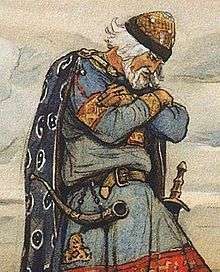 | ? | 879-912 | 912 | Unknown | Varangian kniaz of Holmgård (Novgorod) and Kønugård (Kiev). His relationship with the family is unknown. He was probably a regent, in name of Igor, son of Rurik. Also Grand Prince of Rus' |
| Igor I the Old Igor Rurikovich | 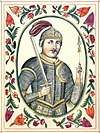 | c.878 Son of Rurik I | 912-945 | 945 Iskorosten aged 66–67 |
901 or 902 at least one son | Son of Rurik. Also Grand Prince of Rus' |
| Saint Olga of Kiev | 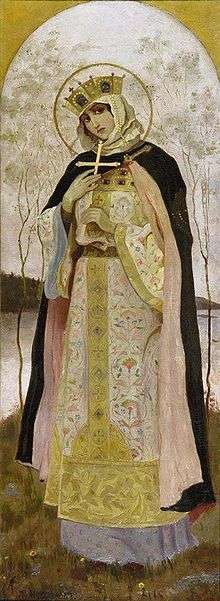 | c.890 Pskov | 945-962 | 11 July 969 Kiev aged 78–79 | Regent on behalf of her minor son, she was baptized by Emperor Constantine VII but failed to bring Christianity to Kiev. | |
| Sviatoslav I the Brave Sviatoslav Igorevich |  | c.942 possibly Kiev Son of Igor I and Olga | 962-969 | March 972 | Predslava c.954 two children Malusha/Malfrida[11][12] c.958 at least one son | Also Grand Prince of Rus' |
| Vladimir I the Great Vladimir Sviatoslavich | 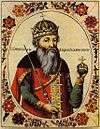 | c.958 Budyatychi Son of Sviatoslav I and Malusha/Malfrida | 969-977 979-988 | 15 July 1015 Berestove, Kiev aged 57–58 | Olava/Allogia c.977 at least one son A Greek nun (widow of his brother) c.980 at least one son Rogneda of Polotsk c.978 (possibly in bigamy) eight children Adela (of Bulgaria?) at least two children (maximum four) Malfrida (of Bohemia?) Before 1000 two children Anna Porphyrogenita of Byzantium 988 Cherson three children Regelindis (?) of Saxony (granddaughter of Otto I, Holy Roman Emperor) After 1011 one or two daughters Unknown two children | His early rule is characterized by a staunch pagan reaction but in 988 he was baptized into Orthodoxy and successfully converted Kievan Rus' to Christianity. |
| Yaropolk I Yaropolk Sviatoslavich | 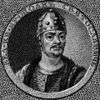 | c.950 Son of Sviatoslav I and Predslava | 977-979 | 980 Fort of Roden, near Kaniv aged 29-30 | A greek nun at least one son | Also Grand Prince of Rus' |
| Viacheslav I Viacheslav Vladimirovich | 977 Son of Vladimir I and Olava/Allogia | 988-1010 | c.1010 Novgorod aged 32-33 | Anna before 1052 at least two children | ||
| Yaroslav I the Wise Yaroslav Vladimirovich | 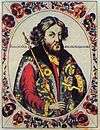 | c.978 Son of Vladimir I and Rogneda of Polotsk | 1010-1034 | 20 February 1054 Vyshhorod aged 75–76 | Ingigerda of Sweden 1019 Novgorod eight or nine children | During his reign Kievan Rus' reached the pinnacle of its power. |
| Vladimir II Vladimir Yaroslavich | 1020 Son of Yaroslav I and Ingigerda of Sweden | 1034-1052 | 4 October 1052 Novgorod aged 31-32 | Anna before 1052 at least two children | ||
| Iziaslav I Iziaslav Yaroslavich | 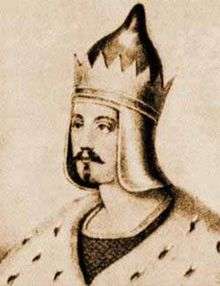 | c.1024 Son of Yaroslav I and Ingigerda of Sweden | 1052-1054 | 3 October 1078 Nizhyn aged 53–54 | Gertrude of Poland 1043 three children | First King of Rus', Pope Gregory VII sent him a crown from Rome in 1075. |
| Mstislav I Mstislav Iziaslavich | before 1054 Son of Iziaslav I and Gertrude of Poland | 1054-1067 | 1069 aged at least 14-15 | Unknown one child | ||
| Gleb I Gleb Sviatoslavich | 1052 Son of Sviatoslav II of Kiev and Cecilia | 1067-1078 | 30 May 1078 Novgorod aged 25-26 | Unmarried | ||
| Sviatopolk I Sviatopolk Iziaslavich |  | 8 November 1050 Son of Iziaslav I and Gertrude of Poland | 1078-1088 | 26 April 1113 Vyshhorod aged 62 | (Barbara?) of Bohemia[13] c.1085 three children Olenna of the Kipchaks c.1094 four children | Also Grand Prince of Rus' |
| Mstislav II the Great Mstislav Vladimirovich | .jpg) | 1 June 1076 Turov Son of Vladimir II Monomakh and Gytha of Wessex | 1088-1094 1095-1117 | 14 April 1132 Kiev aged 55 | Christina of Sweden 1095 ten children Liubava Dmitrievna of Novgorod 1122 two children | After his reign Kievan Rus' fell into recession starting a rapid decline. |
| David I David Sviatoslavich | 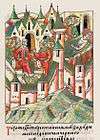 | 1050 Son of Sviatoslav II of Kiev and Cecilia | 1094-1095 | 1123 Chernigov aged 72-73 | Teodosia five children | Son of Sviatoslav II of Kiev. |
Feudal Period
| Ruler | Born | Reign | Death | Consort | Notes | |
|---|---|---|---|---|---|---|
| Vsevolod I | 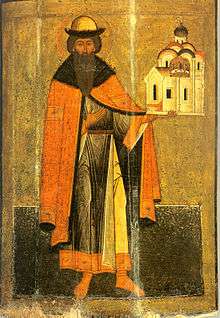 | 1103 | 1117-1132 | 11 February 1138 | Anna before 1125 four children | |
| Sviatopolk II | After 1096 | 1132 | 20 February 1154 | Euphemia of Olomouc[14] 1143 or 1144 no children | Also Prince of Polotsk and Pskov. | |
| Vsevolod I |  | 1103 | 1132-1136 | 11 February 1138 | Anna before 1125 four children | |
| Sviatoslav II |  | 1106/1107 | 1136-1138 | 1164 | Unknown six children | |
| Sviatopolk II | After 1096 | 1138 | 20 February 1154 | Euphemia of Olomouc[15] 1143 or 1144 no children | Also Prince of Polotsk and Pskov. | |
| Rostislav I | ? | 1138-1140 | 6 April 1151 | Unknown before 1151 three children | ||
| Sviatoslav II |  | 1106/1107 | 1140-1141 | 1164 | Unknown six children | |
| Sviatoslav III | 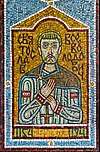 | 1123 | 1141 | 25 July 1194 | Maria of Polotsk 1143 eight children | |
| Rostislav I | ? | 1141-1142 | 6 April 1151 | Unknown before 1151 three children | ||
| Sviatopolk II | After 1096 | 1142-1148 | 20 February 1154 | Euphemia of Olomouc[16] 1143 or 1144 no children | ||
| Yaroslav II | 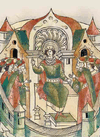 | 1132 | 1148-1154 | 1180 | 'Unknown 1149 four children | |
| Rostislav II |  | 1110 | 1154 | 14 March 1167 | Unknown eight children | |
| David II | 1140 | 1154-1155 | 23 April 1197 | Unknown before 1197 seven children | ||
| Mstislav III |  | ? | 1155-1158 | after 1161 | Unknown | |
| Sviatoslav IV | ? | 1158-1160 | 1170 | Unknown | ||
| Mstislav IV the Eyeless | before 1151 | 1160-1161 | 20 April 1178 | Unknown two children Unknown no children | ||
| Sviatoslav IV | ? | 1161-1168 | 1170 | Unknown | ||
| Roman I the Great | 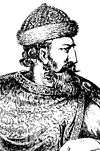 | 1152 | 1168-1170 | 19 June 1205 | Predslava of Kiev 1170 or 1180 two children Anna Angelina of Byzantium c.1197 two children | Also King of Galicia-Volhynia. |
| Rurik II | 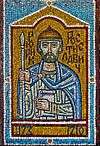 | before 1157 | 1170-1171 | 1215 | Unknown 1163 Anna of Turov[17] before 1176 six children | |
| Yuri I Bogolyubsky | c.1160 | 1171-1175 | c.1194 | Tamar I of Georgia 1185 (annulled 1187) no children| | ||
| Sviatoslav V | ? | 1175 | after 1176 | Unknown | ||
| Mstislav IV the Eyeless | before 1151 | 1175-1176 | 20 April 1178 | Unknown two children Unknown no children | ||
| Yaroslav III the Red | ? | 1176-1177 | 1199 | Unmarried | ||
| Mstislav IV the Eyeless | before 1151 | 1177-1178 | 20 April 1178 | Unknown two children Unknown no children | ||
| Yaropolk II | ? | 1178 | 1182 or after 1196 | Unknown | ||
| Roman II | 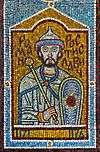 | before 1149 | 1178-1179 | 14 June 1180 | Maria of Novgorod 9 January 1149 three children | |
| Mstislav V the Brave | 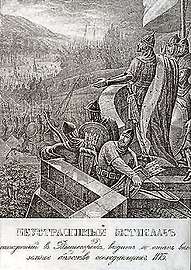 | 1143 | 1179-1180 | 13 July 1180 | ||
| Vladimir III | after 1143 | 1180-1181 | 1200 | Maria of Vladimir-Suzdal 1178 five children | ||
| Yaroslav IV | ? | 1182-1184 | after 1176 | Unknown Alanian wife three children | ||
| Mstislav VI | ? | 1184-1187 | 1189 | Unknown | ||
| Yaroslav IV | ? | 1187-1196 | after 1176 | Unknown Alanian wife three children | ||
| Yaropolk III | after 1174 | 1197 | between 1212 and 1223 | Vasilissa (of Chernigov?) no children | ||
| Yaroslav IV | ? | 1197-1199 | after 1176 | Unknown Alanian wife three children | ||
| Sviatoslav VI |  | 27 March 1196 | 1200-1205 | 3 Februaray 1252 | Eudokia of Murom one child | |
| Konstantin I |  | 18 May 1185 | 1205-1207 | 2 Februaray 1218 | Agafia of Kiev three children | |
| Sviatoslav VI |  | 27 March 1196 | 1207-1210 | 3 Februaray 1252 | Eudokia of Murom one child | |
| Mstislav VII the Bold | _%D0%B8_%D0%94%D0%B0%D0%BD%D0%B8%D0%BB%D0%B0_%D0%93%D0%B0%D0%BB%D0%B8%D1%86%D0%BA%D0%B8%D0%B9.jpg) | 1176 | 1210-1215 | 1228 | Maria of Cumania nine children | |
| Yaroslav V | 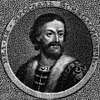 | 8 February 1191 | 1215-1216 | 30 September 1246 | Unknown 1205 no children Rostislava of Novgorod 1214 (annulled 1216) no children Theodosia of Ryazan 1218 twelve children | |
| Mstislav VII the Bold | _%D0%B8_%D0%94%D0%B0%D0%BD%D0%B8%D0%BB%D0%B0_%D0%93%D0%B0%D0%BB%D0%B8%D1%86%D0%BA%D0%B8%D0%B9.jpg) | 1176 | 1216-1217 | 1228 | Maria of Cumania nine children | |
| Sviatoslav VII | ? | 1217-1218 | 1239 | Unknown | ||
| Vsevolod II | ? | 1218-1221 | 1239 | Unknown | ||
| Vsevolod III | 1212 or 1213 | 1221 | 7 February 1238 | Marina of Kiev 1230 no children | ||
| Yaroslav V |  | 8 February 1191 | 1221-1223 | 30 September 1246 | Unknown 1205 no children Rostislava of Novgorod 1214 (annulled 1216) no children Theodosia of Ryazan 1218 twelve children | |
| Vsevolod III | 1212 or 1213 | 1223-1224 | 7 February 1238 | Marina of Kiev 1230 no children | ||
| Saint Michael I |  | 1185 | 1224-1226 | 20 September 1246 | Helena of Galicia-Volhynia 1210 or 1211[18] seven children | |
| Yaroslav V |  | 8 February 1191 | 1226-1228 | 30 September 1246 | Unknown 1205 no children Rostislava of Novgorod 1214 (annulled 1216) no children Theodosia of Ryazan 1218 twelve children | |
| Saint Alexander I Nevsky | 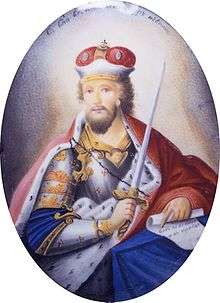 | 13 May 1221 | 1228-1229 | 14 November 1263 | Praskovia-Alexandra of Polotsk 1239 five children Vassilissa before 1263 no children | |
| Saint Michael I |  | 1185 | 1229 | 20 September 1246 | Helena of Galicia-Volhynia 1210 or 1211[18] seven children | |
| Rostislav III | after 1210 | 1229-1230 | 1262 | Anna of Hungary 1243 five children | ||
| Yaroslav V |  | 8 February 1191 | 1230-1236 | 30 September 1246 | Unknown 1205 no children Rostislava of Novgorod 1214 (annulled 1216) no children Theodosia of Ryazan 1218 twelve children | |
| Saint Alexander I Nevsky |  | 13 May 1221 | 1236-1240 | 14 November 1263 | Praskovia-Alexandra of Polotsk 1239 five children Vassilissa before 1263 no children | |
| Andrey I |  | 1220 | 1240-1241 | 1264 | Justina of Galicia three children | |
| Saint Alexander I Nevsky |  | 13 May 1221 | 1241-1252 | 14 November 1263 | Praskovia-Alexandra of Polotsk 1239 five children Vassilissa before 1263 no children | |
| Vasily I | ? | 1252-1255 | 1271 | Unmarried | ||
| Yaroslav VI | 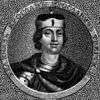 | 1230 | 1255-1256 | 16 September 1272 | Natalia before 1252 two children Saint Xenia of Tarusa 1265 four children | Brother of his predecessor. |
| Vasily I | ? | 1256-1258 | 1271 | Unmarried | ||
| Saint Alexander I Nevsky |  | 13 May 1221 | 1258-1259 | 14 November 1263 | Praskovia-Alexandra of Polotsk 1239 five children Vassilissa before 1263 no children | |
| Dmitry I | 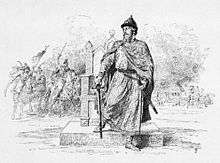 | 1250 | 1259-1263 | 1294 | Unknown four children | |
| Vasily II | 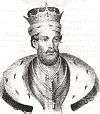 | 1236 or 1241 | 1264-1266 | 1276 | Unknown | |
| Yaroslav VI |  | 1230 | 1266-1267 | 16 September 1272 | Natalia before 1252 two children Saint Xenia of Tarusa 1265 four children | Brother of his predecessor. |
| Vasily II |  | 1236 or 1241 | 1267-1272 | 1276 | Unknown | |
| Dmitry I |  | 1250 | 1272-1273 | 1294 | Unknown four children | |
| Vasily II |  | 1236 or 1241 | 1273-1276 | 1276 | Unknown | |
| Dmitry I |  | 1250 | 1276-1281 | 1294 | Unknown four children | |
| Andrey II | 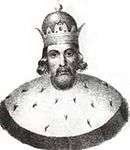 | 1255 | 1281-1285 | 27 July 1304 | Vasilissa of Rostov 1294 three children | |
| Dmitry I |  | 1250 | 1285-1292 | 1294 | Unknown four children | |
| Andrey II |  | 1255 | 1292-1304 | 27 July 1304 | Vasilissa of Rostov 1294 three children | |
| Saint Michael II |  | 1255 | 1304-1314 | 27 July 1304 | Saint Anna of Rostov 1294 five children | |
| Afanasii | ? | 1314-1315 | 1322 | Anna no children | ||
| Saint Michael II |  | 1255 | 1315-1316 | 27 July 1304 | Saint Anna of Rostov 1294 five children | |
| Afanasii | ? | 1316-1322 | 1322 | Anna no children | ||
| Yuri (George) II |  | 1281 | 1322-1325 | 21 November 1325 | Unknown 1297 one child Konchaka of Mengu-Timur (baptised Agafia) 1317 no children | |
| Alexander II |  | 7 October 1301 | 1325-1327 | 29 October 1339 | Anastasia of Galicia 1320 eight children | |
Part of Moscow
- 1328-1337 Ivan I Kalita the Money-bag
- 1337-1353 Simeon the Proud
- 1353-1359 Ivan II the Fair
- 1359-1363 Dmitry II the One-eyed, 1359–1363
- 1363-1389 Dmitry III of the Don
Gediminids
- 1389-1407 Lengvenis
House of Rurik
- 1408-1425 Vasily III, 1408–1425
- 1425-1462 Vasily II the Blind, 1425–1462
- 1462-1480 Ivan III the Great
References
- ↑ Dmitry Likhachev, ed. and trans., Povest Vremennikh Let (Moscow and Augsburg: Im Werden Verlag, 2003), 7.
- ↑ Boris Grekov, “Revoliutsiia v Novgorode v XII veke,” Uchenye zapiski Instituta Istorii Rossiiskoi assotsiatsii nauchno-issledovatel’skikh institutov obshchestvennykh nauk (RANION) vol. 4 (1929): 13-21; V. L. (Valentin Lavrent’evich) Yanin, “Problemy sotsial'noi organizatsii novgorodskoi respubliki,” Istoriia SSSR, 1 (1970), 44; Valentin Yanin, Novgoroskie Posadniki (Moscow: Yazyki Slavianskoi kul'tury, 2003), 64-135.
- ↑ Michael C. Paul, "Was the Prince of Novgorod a 'Third-rate bureaucrat' after 1136?" Jahrbücher für Geschichte Osteuropas 56, No. 1 (Spring 2008): 72-113.
- ↑ Paul, "Was the Prince of Novgorod a 'Third-rate bureaucrat' after 1136?" 94-97.
- ↑ Michael C. Paul, “The Iaroslavichi and the Novgorodian Veche 1230-1270: A Case Study on Princely Relations with the Veche,” Russian History/ Histoire Russe 31, No. 1-2 (Spring-Summer, 2004): 39-59.
- ↑ Arseny Nasonov, ed., Novgorodskaia Pervaia Letopis Starshego i mladshego izvodov (Moscow and Leningrad, ANSSSR, 1950), 43, 236; Novgorodskaia chetvertaia letopis, vol. 4 of Polnoe Sobranie Russkikh Letopisei (Moscow: Iazyki russkoi kul'tury, 2000), 177; George Vernadsky, Kievan Russia (New Haven: Yale University Press, 1948), 197.
- ↑ N. L. (Natalia L’vovna) Podvigina, Ocherki sotsial’no-ekonomicheskoi i politicheskoi istorii Novgoroda Velikogo v XII-XIII vv. (Moscow: Vysshaia shkola, 1976), 114; Paul, "Was the Prince of Novgorod a 'Third-rate bureaucrat' after 1136?" 82-94.
- ↑ On the fur trade, see Janet Martin, Treasure of the Land of Darkness: The Fur Trade and Its Significance for Medieval Russia (Cambridge: Cambridge University Press, 1985); Paul, "Was the Prince of Novgorod a 'Third-Rate Bureaucrat' after 1136?"; see also the relevant sections (re: Novgorod) in Janet Martin, Medieval Russia: 980-1584, (New York: Cambridge University Press, 1995).
- ↑ See Yanin, Novgoroskie Posadniki.
- ↑ See also the list in Paul, "Was the Prince of Novgorod a 'Third-rate bureaucrat' after 1136?" 109-113.
- ↑ Vladimir Plougin: Russian Intelligence Services: The Early Years, 9th-11th Centuries, Algora Publ., 2000
- ↑ History of Ukraine-Rus': From prehistory to the eleventh century, Canadian Institute of Ukrainian Studies Press, 1997
- ↑ According to A. Nazarenko. It was thought not long ago that the first wife of Sviatopolk was Barbara Komnene, a supposed daughter of Alexios I Komnenos. However, the lack of tradition of such a name in the Byzantine Empire led to doubt. Today she may be considered fictional.
- ↑ Л.Войтович КНЯЗІВСЬКІ ДИНАСТІЇ СХІДНОЇ ЄВРОПИ
- ↑ Л.Войтович КНЯЗІВСЬКІ ДИНАСТІЇ СХІДНОЇ ЄВРОПИ
- ↑ Л.Войтович КНЯЗІВСЬКІ ДИНАСТІЇ СХІДНОЇ ЄВРОПИ
- ↑ Template:ВТ-МЭСБЕ
- 1 2 Thurston, Herbert (Editor). Butler’s Lives of the Saints - September.